Lab Meat?
- Posted 01.10.06
- NOVA scienceNOW
(This video is no longer available for streaming.) Some people avoid meat because it involves killing animals. Other people love meat; they can't get enough. Here is a development that might make both sides happy: lab-made meat. In this NOVA scienceNOW video, reporter Win Rosenfeld shares this juicy story.
Transcript
LAB MEAT?
PBS Airdate: January 10, 2006
ROBERT KRULWICH: Ummm, meat—this is a story about meat. Some people avoid meat because it involves killing animals. Other people love meat. They can't get enough. Here is a development that might make both sides happy. Reporter Win Rosenfeld has the story.
DANIEL NEWMARK: I like meat. I eat it all the time.
JAY GONZALES: Pork chops, steaks...
MAYE MUSK: I love hamburger.
WIN ROSENFELD (Correspondent): You might not have thought about it, but that hamburger that he's about to put in his mouth, it's inefficient to produce.
BOB LILIENFELD (Author): ...because of all the water, grains, chemicals, fertilizers, everything it took to turn grass into cows and cows into meat, and get the meat to your house.
WIN ROSENFELD: That's a lot of energy and a lot of waste. And meat can make us sick, and we do have to kill billions of animals. Jason Matheny of the University of Maryland says he's got the answer.
JASON MATHENY (University of Maryland): What we're doing here is cloning, effectively, the muscle cells from the farm animal.
WIN ROSENFELD: Cloning meat?
JASON MATHENY: That's right.
WIN ROSENFELD: Who's going to eat that?
HARRY BIXLER: As long as it wasn't poisonous, I'd give it a try.
CATHERINE CARABALLO: If I can't tell the difference, of course I'd eat it.
MONIQUE CHANG: As long as it tastes the same.
JASON MATHENY: If you start out a chicken cell, it should taste like chicken.
WIN ROSENFELD: Then again, doesn't everything. How about texture?
JASON MATHENY: Farm animals produce meat of a certain texture because they move around. We have to mimic those conditions in vitro.
WIN ROSENFELD: In vitro meaning?
JASON MATHENY: Literally, stretch the cells mechanically.
WIN ROSENFELD: Exercise cells in a lab? Okay, so the only question left is...
CATHERINE CARABALLO: You got a piece?
WIN ROSENFELD: Here it is: cultured meat.
CROWD: Bon appetit, bon appetit.
WIN ROSENFELD: Now, this piece was made by scientists at the University of Western Australia. NASA's been interested, and the Dutch government has invested $5,000,000 dollars in cultured meat. Right now, you have to clone a cell, stretch it on a scaffold, and feed it an expensive, nutritious soup. This makes each little bit very costly. What if I wanted a little more?
JASON MATHENY: If you wanted to pay a million dollars, right now, we could get you a kilogram of beef.
WIN ROSENFELD: No thanks, I'll stick with this, for now.
Credits
Lab Meat?
- Executive Producer
- Samuel Fine
- Executive Editor
- Robert Krulwich
- Senior Series Producer
- Vincent Liota
- Senior Producer
- Robe Imbriano
- Producers
- Julia Cort
Carla Denly
Robe Imbriano
Dean Irwin
Vincent Liota
Mary Robertson
Win Rosenfeld - Editors
- Ben Ehrlich
Nathan Hendrie
Robe Imbriano
Vincent Liota
Win Rosenfeld - Supervising Producer
- Andrea Cross
- Development Producer
- Kyla Dunn
- Program Editor
- Steve Trevisan
- Associate Producers
-
Anthony Manupelli
Mary Robertson
Win Rosenfeld
Ayo Babatunde
Shimona Shahi - Unit Manager
- Candace White
- Production Secretary
- Ayo Babatunde
- Compositing
- Yunsik Noh
- Production Assistant
- Robbie Gemmel
- Music
- Rob Morsberger
- NOVA scienceNOW Series Animation
- Edgeworx
- Camera
- Chris Borghesani
George Delgado
Brian Dowley
Tom Fahey
Vikram Gandhi
Robert Hanna
Michael Hunkley - Sound Recordists
- Paul Austin
Vikram Gandhi
Mike Karas
Dennis McCarthy
Gilles Morin
Alex Sullivan - Audio Mix
- John Jenkins
- Animation
- Mitch Butler
Edgeworx
Picket Design
Pie Design - Special Thanks
- Clifford Cunningham
Foxwoods Resort Casino
The Graduate Center at CUNY
Alex Meissner
Naturally Tasty Health Food
The New York Number Theory Seminar
The officers and crew of the NOAA ships Delaware II and Albatross IV
Jí¡nos Pintz
Salon Mario Russo
Cem Yildirim
Adam Zoghlin - Archival Material
- ABC News Video Source
Art. Lebedev Studio
Mike Brown, Caltech
Michael Brumlik
Jewel Webb Chambers
CNN
CORBIS Motion
Michael DiGiorgio, Worldwide Nature Artists Group
Denis Finnin, American Museum of Natural History
Richard Gibbe
Dennis Kunkel Microscopy, Inc.
Robert Hurt (IPAC)
Jupiterimages Corporation
The Macaulay Library at the Cornell Lab of Ornithology
MODIS Rapid Response Project at NASA/GSF
Museum of Comparative Zoology, Harvard University
NASA/JPL
NASA/JPL-Caltech
Jay Pitocchelli
Prairie Pictures / StormStock, Martin Lisius
24 Images
N. John Schmitt
Ultimate Chase Stock Video
Mitch Waite
WWL-TV - NOVA Series Graphics
- yU + co.
- NOVA Theme Music
- Walter
Werzowa
John Luker
Musikvergnuegen, Inc. - Additional NOVA Theme Music
- Ray Loring
- Post Production Online Editor
- Spencer Gentry
- Closed Captioning
- The Caption Center
- NOVA Administrator
- Dara Bourne
- Publicity
- Eileen Campion
Olivia Wong - Senior Researcher
- Barbara Moran
- Production Coordinator
- Linda Callahan
- Unit Managers
- Lola
Norman-Salako
Carla Raimer - Paralegal
- Richard Parr
- Legal Counsel
- Susan Rosen Shishko
- Post Production Assistant
- Alex Kreuter
- Associate Producer, Post Production
- Patrick Carey
- Post Production Supervisor
- Regina O'Toole
- Post Production Editor
- Rebecca Nieto
- Post Production Manager
- Nathan Gunner
- Supervising Producer
- Stephen Sweigart
- Producer, Special Projects
- Susanne Simpson
- Coordinating Producer
- Laurie Cahalane
- Senior Science Editor
- Evan Hadingham
- Senior Series Producer
- Melanie Wallace
- Managing Director
- Alan Ritsko
- Senior Executive Producer
- Paula S. Apsell
NOVA scienceNOW is a trademark of the WGBH Educational Foundation
This material is based upon work supported by the National Science Foundation under Grant No. 0229297. Any opinions, findings, and conclusions or recommendations expressed in this material are those of the author(s) and do not necessarily reflect the views of the National Science Foundation.
© 2006 WGBH Educational Foundation
All rights reserved
- Image credit: (cheeseburger) © James Noble/CORBIS
Participants
- Robert Lilienfeld
- President, The Cygnus Group
- Jason Matheny
- Researcher at the Bloomberg School of Public Health, Johns Hopkins University
Related Links
-
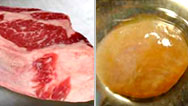
Virtual Taste Test
Compare the look, feel, taste, and smell of lab-produced meat with the real thing, then vote in our poll.
-
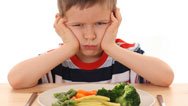
The Science of Picky Eaters
Don't like broccoli? Your DNA may explain why, because your sense of taste is largely encoded in your genes.
-
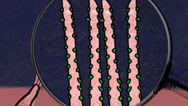
Tour the Tongue
Learn how our sense of taste works, and why we evolved the ability to detect flavors like bitter and sweet.
-
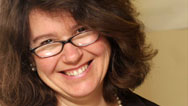
Picky Eaters: Expert Q&A
Geneticist Danielle Reed answers questions about taste, its genetic roots, and more.
-
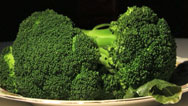
Blocking Bitter Taste
Neil deGrasse Tyson meets a genetically modified mouse that can't sense bitter tastes.



